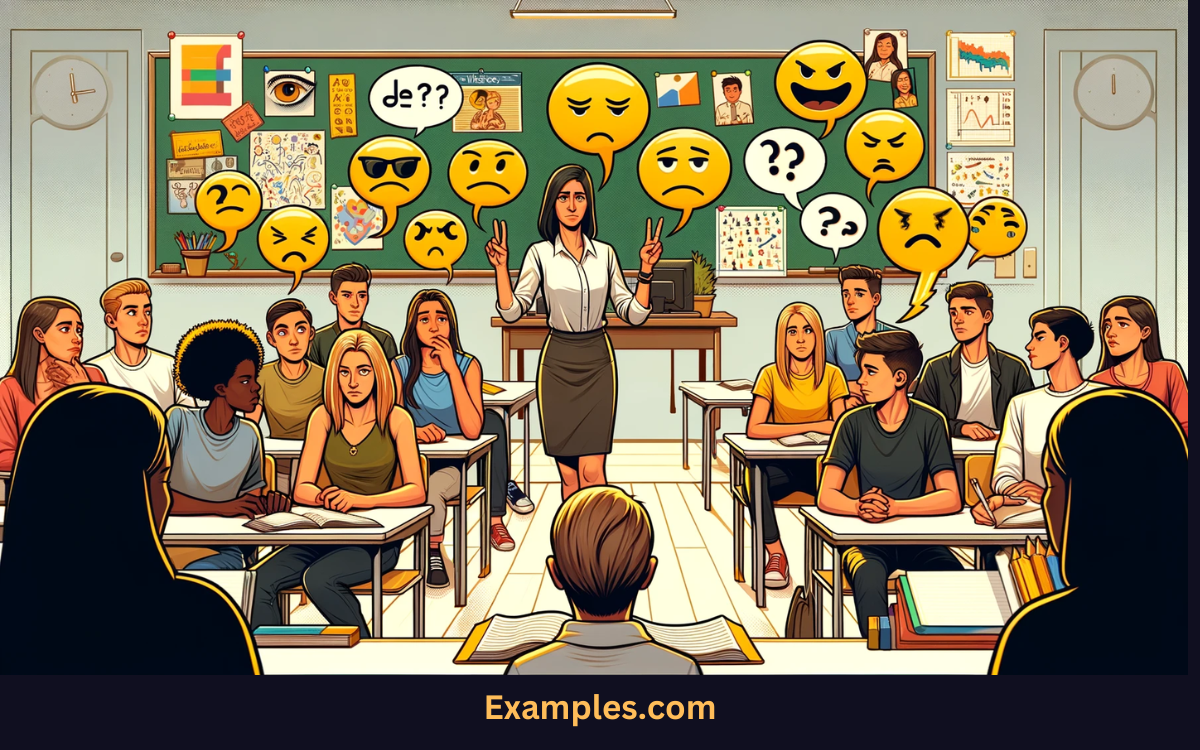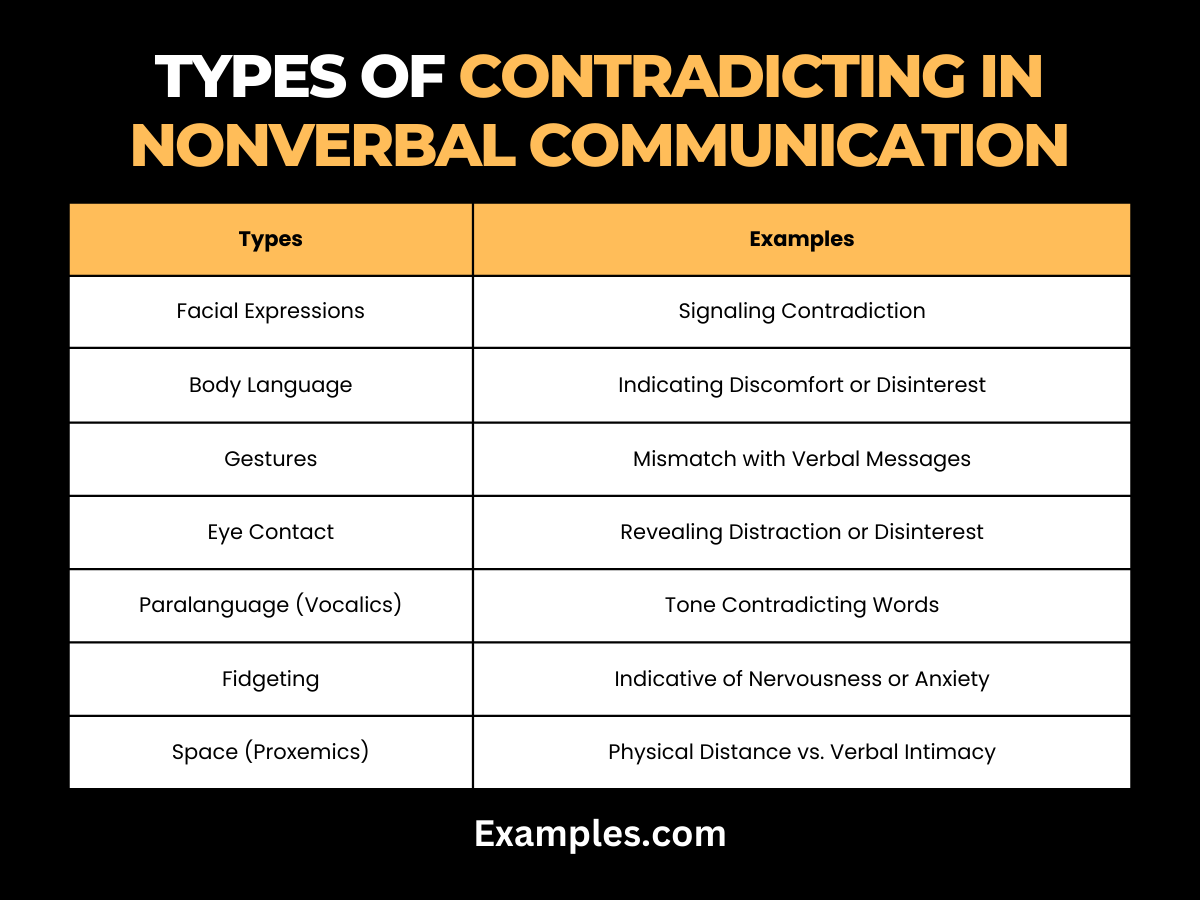29+ Contradicting in Nonverbal Communication Examples
Contradicting in nonverbal communication refers to instances where body language, facial expressions, or other nonverbal cues conflict with the verbal message being conveyed. This phenomenon is crucial in understanding the complexity and depth of human communication. Recognizing these contradictions can reveal hidden emotions or intentions that words alone may not express, offering a more profound insight into interpersonal interactions. This guide explores how to identify and interpret these contradictions for more effective and authentic communication.
What is Contradicting in Nonverbal Communication?

Contradicting in nonverbal communication occurs when nonverbal cues conflict with verbal messages. This dissonance can indicate doubt, deception, or mixed emotions, affecting the credibility of the communication. Understanding these contradictions is essential for accurately interpreting messages and intentions in various interactions.
Contradicting in Nonverbal Communication Examples
Nonverbal communication is a complex and integral part of human interaction, often complementing or even contradicting verbal messages. Here are examples illustrating how nonverbal cues can contradict verbal communication:
- Facial Expressions in Nonverbal Communication: A person might verbally express happiness or satisfaction, but their facial expression shows sadness or displeasure. This incongruence can lead to confusion in understanding the person’s true feelings.
- Body Language in Nonverbal Communication: Someone might say they are comfortable in a situation, yet their closed body posture, like crossed arms or legs, indicates discomfort or defensiveness.
- Gestures in Nonverbal Communication: Nodding while verbally expressing disagreement.
- Eye Contact in Nonverbal Communication: Avoiding eye contact while expressing honesty.
- Fidgeting in Body Language: Fidgeting excessively while stating they are calm.
- Touch/Haptics: A reassuring pat that feels too forceful or aggressive.
- Nodding in Interactions: Nodding yes while saying no.
- Space (Proxemics): Invading personal space while talking about respecting boundaries.

- Physical Appearance: Disheveled appearance while discussing professionalism.
- Artifacts (Personal Objects): Wearing casual attire in a formal business meeting.
- Paralanguage (Vocalics): A shaky voice when claiming confidence.
- Silence in Nonverbal Communication: Remaining silent when asked for an opinion.
- Time (Chronemics): Being late for a meeting about punctuality.
- Body Movements: Shaking head while saying yes.
- Body Postures: Slouching during a motivational speech.
- Sign Language in Nonverbal Communication: Signing ‘happy’ with a sad facial expression.

- Adaptors in Nonverbal Communication: Nail biting while discussing stress management techniques.
- Complementing in Nonverbal Communication: Smiling while delivering bad news.
- Accenting in Nonverbal Communication: Soft voice tone while making a strong point.
- Repeating in Nonverbal Communication: Gesturing ‘come here’ while saying ‘stay there’.
- Regulating in Nonverbal Communication: Interrupting frequently during a conversation about active listening.
- Substituting in Nonverbal Communication: Rolling eyes instead of verbally expressing disagreement.
- Nonverbal Communication Skills: Poor eye contact in a communication skills workshop.
- Nonverbal Communication in the Workplace: Closed posture in a team-building exercise.
- Nonverbal Communication Examples in School: Yawning while talking about an exciting project.

- Nonverbal Communication for Nurses: Impatient body language while discussing patient care.
- Nonverbal Communication in Different Cultures: A thumbs-up in a culture where it’s considered rude.
- Verbal vs Nonverbal Communication: Saying ‘I’m fine’ with a tearful voice.
- Advantages and Disadvantages of Nonverbal Communication: Over-relying on email in a situation that requires face-to-face interaction.
- Kinesics in Nonverbal Communication: Shrugging shoulders while making a definitive statement.
Types of Contradicting in Nonverbal Communication

Contradicting in nonverbal communication occurs when nonverbal cues conflict with verbal messages, creating confusion or misunderstanding. Two primary forms are:
- Facial Expressions in Nonverbal Communication: A person might verbally express agreement, but their facial expression, such as a frown or a look of disbelief, can directly contradict their words. This misalignment can signal doubt or disagreement.
- Body Language in Nonverbal Communication: Someone might say they are comfortable in a situation, yet their closed-off body posture, like crossed arms or avoiding eye contact, can contradict this, indicating discomfort or disinterest.
- Gestures in Nonverbal Communication: When a person’s gestures don’t align with their verbal message, it can indicate contradiction. For example, a thumbs-up sign while verbally expressing displeasure shows a clear mismatch.
- Eye Contact in Nonverbal Communication: Inconsistent eye contact can also be telling. Saying one is listening or interested, but frequently avoiding eye contact, may suggest distraction or disinterest.
- Paralanguage (Vocalics) in Nonverbal Communication: The tone, pitch, and speed of speech can contradict the spoken words. For instance, a monotone voice while expressing excitement can convey disinterest or insincerity.
- Fidgeting in Body Language of Nonverbal Communication: Fidgeting, like tapping feet or playing with objects, while claiming to be calm or confident, can suggest nervousness or anxiety, contradicting the verbal message.
- Space (Proxemics) in Nonverbal Communication: The physical distance maintained during a conversation can contradict verbal expressions of familiarity or comfort. Standing too far away while expressing closeness can indicate discomfort or reserve.
- Nodding in Interactions for Nonverbal Communication: Nodding usually signifies agreement, but if someone nods while verbally expressing disagreement or uncertainty, it creates a contradictory message.
- Touch / Haptics in Nonverbal Communication: The use of touch can sometimes contradict verbal messages. For instance, a reassuring pat on the back accompanied by a tense or uncomfortable facial expression can send mixed messages about the person’s true feelings of reassurance or support.
Importance of Contradicting in Nonverbal Communication
- Reveals Incongruence: Contradicting nonverbal signals can reveal a discrepancy between what is being said and what is truly meant. For example, a person might verbally agree but body language in nonverbal communication, like crossed arms, might suggest disagreement.
- Signals Discomfort or Deception: Inconsistent nonverbal cues, such as avoiding eye contact in nonverbal communication while speaking affirmatively, can indicate discomfort or deceit.
- Enhances Interpretation of Messages: When nonverbal behavior contradicts verbal communication, it prompts the receiver to seek a deeper understanding of the underlying message, often leading to more meaningful interactions.
- Cultural Interpretations: In different cultures, certain nonverbal behaviors can have varying meanings. What might be considered a contradiction in one culture may not be in another.
- Improves Communication Skills: Recognizing and understanding contradictory nonverbal cues can significantly enhance one’s communication skills, making interactions more effective and empathetic.
- Aids in Conflict Resolution: Identifying contradictions between what is said and the nonverbal communication can be crucial in resolving misunderstandings or conflicts.
- Enhances Emotional Intelligence: Being attuned to contradictory nonverbal signals can improve emotional intelligence, aiding in social interactions and relationships.
How to Improve Contradicting in Nonverbal Communication?
Improving awareness and control over contradicting cues in nonverbal communication is essential for clear and effective interactions. Here are some concise tips:
Increase Self-Awareness
- Reflect on Your Cues: Regularly reflect on your nonverbal behaviors and how they might contrast with your verbal messages.
- Seek Feedback: Ask for feedback from others on how your nonverbal communication is perceived.
Practice Consistency
- Align Verbal and Nonverbal Messages: Make a conscious effort to ensure that your body language, facial expressions, and tone match your spoken words.
- Role-Playing Exercises: Engage in role-playing scenarios to practice aligning your nonverbal cues with your verbal communication.
Observe and Learn
- Study Nonverbal Communication: Observe how others use nonverbal cues and how these might sometimes contradict their words.
- Learn from Experts: Watch public speakers or actors and notice how they use nonverbal communication effectively.
Enhance Emotional Intelligence
- Understand Your Emotions: Develop a deeper understanding of your emotions to avoid unintentional nonverbal contradictions.
- Emotional Regulation: Work on regulating your emotions to maintain consistency between your feelings and how they are expressed nonverbally.
In wrapping up the discussion on contradicting in nonverbal communication, it’s clear that understanding and accurately interpreting these nonverbal cues is as important as the verbal content of communication. The subtleties of body language, facial expressions, and other nonverbal signals can unveil deeper insights into a person’s true feelings and thoughts, often more than words can convey. Recognizing and appropriately responding to these contradictions is a skill that enhances personal and professional relationships, ensuring clearer and more effective communication.
For further exploration into the complexities of nonverbal communication, the Stanford University’s Social Media Lab provides valuable resources and research findings. Additionally, the American Psychological Association offers extensive materials on the psychological aspects of nonverbal communication, which can deepen understanding of these intricate dynamics. Leveraging these resources can equip individuals with the knowledge to navigate the nuances of nonverbal cues more confidently and effectively in various communication scenarios.



